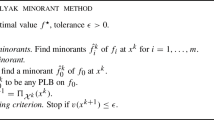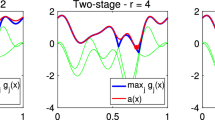Abstract
This paper presents two linear cutting plane algorithms that refine existing methods for solving disjoint bilinear programs. The main idea is to avoid constructing (expensive) disjunctive facial cuts and to accelerate convergence through a tighter bounding scheme. These linear programming based cutting plane methods search the extreme points and cut off each one found until an exhaustive process concludes that the global minimizer is in hand. In this paper, a lower bounding step is proposed that serves to effectively fathom the remaining feasible region as not containing a global solution, thereby accelerating convergence. This is accomplished by minimizing the convex envelope of the bilinear objective over the feasible region remaining after introduction of cuts. Computational experiments demonstrate that augmenting existing methods by this simple linear programming step is surprisingly effective at identifying global solutions early by recognizing that the remaining region cannot contain an optimal solution. Numerical results for test problems from both the literature and an application area are reported.
Similar content being viewed by others
References
Al-Khayyal F. (1990): Jointly constrained bilinear programs and related problems: an overview. Comput. Math. Appl. 19(11): 53–62
Al-Khayyal F., Falk J.E. (1983): Jointly constrained biconvex programming. Math. Oper. Res. 8, 273–286
Al-Khayyal F., Kyparisis J. (1991): Finite convergence of algorithms for nonlinear programs and variational inequalities. J. Optim. Theory Appl. 70, 319–332
Alarie S., Audet C., Jaumard B., Savard G. (2001): Concavity cuts for disjoint bilinear programming. Math. Program. 90(2): 373–398
Altman M. (1968): Bilinear programming. Bull D’ Acad Pol. Des Sci. 16(9): 741–746
Audet C., Hansen P., Jaumard B., Savard G. (1999): A symmetrical linear maxmin approach to disjoint bilinear programming. Math. Program. 85(3): 573–592
Balas E. (1971): Intersection cuts—a new type of cutting planes for integer programming. Oper. Res. 19, 19–39
Danielson M., Ekenberg L. (1998): A framework for analyzing decisions under risk. Eur. J. Oper. Res. 104(3): 474–484
Falk J.E. (1973): A linear max-min problem. Math. Program. 5, 169–188
Gallo G., Ülkücü A. (1977): Bilinear programming: an exact algorithm. Math. Program. 12, 173–194
Horst R., Tuy H. (1996): Global Optimization: Deterministic Approaches, 3rd edn. Springer-Verlag, Berlin
Júdice J.J., Faustino A.M. (1991): Computational analysis of LCP methods for bilinear and concave quadratic programming. Comp. Oper. Res. 18(9): 645–654
Konno H. (1976a): A cutting plane algorithm for solving bilinear programs. Math. Program. 11, 14–27
Konno H. (1976b): Maximization of a convex quadratic function under linear constraints. Math. Program. 11, 117–127
Majthay M., Whinston A. (1974): Quasi-concave minimization subject to linear constraints. Discrete Math. 9, 35–59
Mangasarian O.L. (1964): Equilibrium points of bimatrix games. SIAM J. 12, 778–780
Mangasarian O.L., Stone H. (1964): Two-person nonzero-sum games and quadratic programming. J. Math. Anal. Appl. 9, 345–355
Meyer C. (2000): A simple finite cone covering algorithm for concave minimization. J. Global Optim. 18(4): 357–365
Shapiro A., Al-Khayyal F. (1993): First-order conditions for isolated locally optimal solutions. J. Optim. Theory Appl. 77, 189–196
Sherali H.D., Alameddine A. (1992): A new reformulation linearization algorithm for bilinear programming problems. J. of Global Optim. 2, 379–410
Sherali H.D., Shetty C.M. (1980): A finitely convergent algorithm for bilinear programming problems using polar cuts and disjunctive face cuts. Math. Program. 19, 14–31
Soland R.M. (1974): Optimal facility location with concave costs. Oper. Res. 22, 373–382
Thieu T.V. (1988): A note on the solution of bilinear problems by reduction to concave minimization. Math. Program. 41, 249–260
Tuy H. (1964): Concave programming under linear constraints. Soviet Math. 5, 1437–1440
Tuy, H. (1995): DC optimization: theory, methods and algorithms. In: Handbook of Global Optimization. Kluwer Academic Publishers, Dordrecht
Tuy H. (1998): Convex Analysis and Global Optimization. Kluwer Academic Publishers, Dotdrecht
Vaish H., Shetty C.M. (1976): The bilinear programming problem. Math. Program. 23, 303–309
Vaish H., Shetty C.M. (1977): A cutting plane algorithm for the bilinear programming problem. Naval Res. Logist. Quart. 24, 83–94
White D.J. (1992): A linear programming approach to solving bilinear programmes. Math. Program. 56, 45–50
Yajima Y., Konno H. (1991): An efficient algorithm for solving rank two and rank three bilinear programming problems. J. Global Optim. 1, 155–171
Zwart P. (1973): Nonlinear programming: counterexamples to two global optimization algorithms. Oper. Res. 21(6): 1260–1266
Author information
Authors and Affiliations
Corresponding author
Rights and permissions
About this article
Cite this article
Ding, X., Al-Khayyal, F. Accelerating convergence of cutting plane algorithms for disjoint bilinear programming. J Glob Optim 38, 421–436 (2007). https://doi.org/10.1007/s10898-006-9091-3
Received:
Accepted:
Published:
Issue Date:
DOI: https://doi.org/10.1007/s10898-006-9091-3




